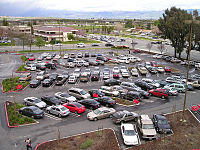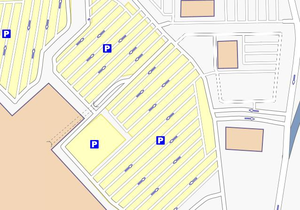Tag:amenity=parking
| Description |
|---|
| A place for parking cars |
| Rendering in OSM Carto |
| Rendering in OSM Carto |

|
| Group: Parking |
| Used on these elements |
| Useful combination |
| See also |
| Status: de facto |
| Tools for this tag |
|
Use amenity=parking to tag a facility used by the public, customers, or other authorised users for parking motor vehicles, such as cars and trucks, commonly known as a car park (British English) or parking lot (American English). See the Parking page for tags specific to parking for other types of vehicles and situations.
How to Map
The most common way to map a car park is to draw an area and tag it with amenity=parking. If you don't know the actual car park area or don't have time to draw it out then just tag a ![]() node (but never use both a node and an area for the same facility). Car parks are a preset in most common editors, e.g. as "Car Parking" in iD, and can be accessed via text autocompletion.
node (but never use both a node and an area for the same facility). Car parks are a preset in most common editors, e.g. as "Car Parking" in iD, and can be accessed via text autocompletion.
Roads, footways, etc. into the parking area should connect to each other within the parking area. A common mistake is to connect roads and footways to the edge of the amenity=parking area but end them there without indicating how to navigate within the parking area. Routers generally are unable to route within an area without explicit roads and paths. [1] However, for multi-storey parking garages, it may not be possible to discern the parking aisles from aerial imagery, so connecting the roads to the edge of the parking garage with amenity=parking_entrance is a good first step until someone is able to survey the inside of the garage.
Parking along the side of streets is tagged with parking:lane=*.
Additional Tags
| Key | Default | Value | Element | Comment |
|---|---|---|---|---|
| amenity | N/A | parking | Tag either an area or a central node, but not both. | |
| All sub-tags below are optional. | ||||
| name | None | * | The name of the car park. | |
| ref | None | * | ||
| access | N/A | yes; customers; permissive; private | Distinction between public car parks, customers car parks (such as at cinemas, etc.), and private car parks (such as for staff in a business park). In this case, yes denotes a public car park. | |
| parking | None | surface | A dedicated area for parking consisting of one level of parking on the ground. | |
| multi-storey | Two or more levels of parking decks in a building structure. Please consider adding the appropriate building=* tag, if it is purpose-built for this purpose, building=parking is the most popular value. | |||
| underground | Underground parking. | |||
| rooftop | One level of a parking deck on top of the building. | |||
| sheds | Private hangars for vehicles, located close to owner's home. Usually constructed of profiled metal. | |||
| carports | Structure used to offer limited protection to vehicles, primarily cars, from the elements (Carports on Wikipedia). Please consider adding building=carport. | |||
| garage_boxes | One level buildings with individual boxes for one car, each, usually made of brick and metal. Usually, this area belong to garage cooperative with own name, chairman, budget, rules, security, etc. | |||
| street_side | Area suitable or designated for parking, which is directly adjacent to the carriageway of a road (but not on lane – in this case see parking:lane=*) and can be reached directly from the roadway without having to use an access way. Consider using parking:lane=* if the streetside parking spaces are stretched over a longer section of the road and no micromapping of these areas is desired. | |||
| lane | Parking on the carriage way, including partially on it. Frequently tagged rather with parking:lane=* | |||
| layby | A minimal parking facility alongside a major road where motorists can take a break en-route to their destination. | |||
| park_ride | None | yes; no; bus; train; tram; metro; ferry, etc | Park and ride. Values of the key define connected means of transport. If unsure, use yes. (see Proposal) | |
| fee | no | yes; no; interval | Whether you have to pay a parking fee or not. If the fee must be paid only on certain hours, the same syntax can be used as for opening_hours=*. (See the discussion page.) | |
| supervised | no | yes; no; interval | Whether the cars are guarded to prevent car theft and vandalism. If a guard is only present on certain hours, the same syntax can be used as for opening_hours=*. | |
| capacity | None | number | The amount of available parking spaces, including all special parking spaces (e.g., disabled). Read talk page on this. | |
| capacity:disabled | None | yes; no; number | Defines whether or not dedicated disabled parking spaces are available, usually reserved only for holders of a disabled parking permit ('blue badge' in the UK). If known, the number of spaces can be specified. (replaces the key disabled_spaces=* see proposal). | |
| capacity:parent | None | yes; no; number | Defines whether or not dedicated parent and child parking spaces are available. If known, the number of spaces can be specified. | |
| capacity:charging | None | yes; no; number | Defines whether or not dedicated parking spaces with charging infrastructure for electric vehicles are available. If known, the number of spaces can be specified. | |
| surface | None | see key page | Physical surface of car park. | |
| maxstay | None | see key page | Time limit for parking (e.g., customer parking for 2 hours) | |
| opening_hours | None | see key page | Opening hours of car park. | |
| operator | None | * | Operator of car park. | |
| website | None | * | Website of car park. | |
Related Features
- Roads leading to the carpark and exiting from it should be tagged as highway=service.
- Parking aisles can be tagged as highway=service with service=parking_aisle and appropriate oneway=* tags. As with the rest of the road network, care should be taken to create a routeable network.
- amenity=vending_machine in combination with vending=parking_tickets is used to map ticket machines.
- amenity=parking_entrance is used to map entrances and exits to underground or multi-storey parking facilities.
- amenity=parking_space is used to map an individual parking space.
Standard method to draw parking of a complex size - ones that consists of disjointed areas, or because the area consists of multiple disjunct parts, or has holes is to use multipolygons.
Site Relation Proposal
It has been suggested that the type=site relation can be used with site=parking to group parking spaces and parking entrances together to form one parking facility, as described on Proposed features/parking. Currently however there is almost no support for this among either mappers or data consumers (analysis) - amenity=parking is far more widely used.
Rendering
The Standard tile layer currently renders the "P" logo and a grey background for parking areas (or the "P" in a building style if the building tag is set).
See also
- amenity=bicycle_parking - A parking space designed for bicycles.
- amenity=motorcycle_parking - A place which is designated for parking motorcycles
- amenity=parking_entrance - is used to map entrances and exits to underground or multi-storey parking facilities.
- landuse=garages - land used for large numbers of carports or individual garages
- amenity=parking_space - for tagging individual parking spaces (e.g. disabled parking spaces) within a parking lot or car park
- Parking - an overview of parking for different modes of transport
- amenity=fuel - A retail facility for refueling motor vehicles
- parking:lane=* - for parking alongside a highway
- parking:condition=* - Describes the legal properties of the parking.
- building=carport - A carport is a covered structure used to offer limited protection to vehicles, primarily cars, from the elements.
- highway=rest_area - For an area along a road where a driver can stop and rest, many parking are located there.
- Garage - disambiguation page
- amenity=vending_machine + vending=parking_tickets - A machine selling tickets for parking
- hov=* - Indicates vehicle occupancy requirements of a highway. (for carpooling)

